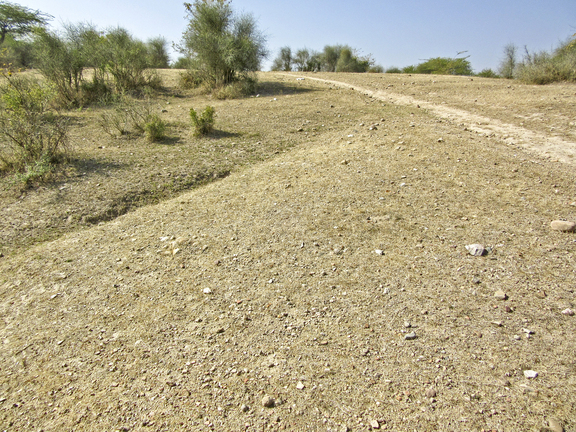
The ancient site (recorded as Bhagwanpura) in the vicinity of Gilund village covers an area of about 460 x 230 meter and is broadly divisible into two parts, western and eastern, rising respectively to heights of about 7 and 14 meter above the surrounding fields. During a small scale excavation under the direction of B. B. Lal during 1959-60 CE, excavation was carried out at three different areas, designated as GLD-1 , GLD-2 and GLD-3. The site was later revisited from 1999 to 2005 by a team from the University of Pennsylvania and the Deccan College in Pune, India. Both sites have been occupied since the beginning of the Chalcolithic period, but it is evident that the eastern mound is taller due to a period of longer occupation. Gilund was occupied from approximately 3000-1700 BCE as the region’s largest chalcolithic site. Two major periods of occupation were identified. Period-I is Chalcolithic in character on account of the presence of a few microliths along with copper. The walls consist of a series of four parallel north-south walls, varying in thickness from 75 to 90 cm while intermediary space measuring between 75 to 105 cm are filled in sand.
All through the period, the residential houses are made of mud brick, the walls also being plastered with mud. Within the houses, are noticed circular clay-lined ovens and open mouthed chulhas. Circular pits with diameter ranging from 90 cm to 1.3 meter and average depth of about 60 cm are lined with a 1.5 to 3 cm thick layer of white clay mixed with sand. The occupants were fully familiar with the use of kiln-burnt bricks. The characteristic ceramic industry of period-I is Black-and-Red Ware, painted over with linear and curvilinear designs in a ceramic white pigment, other wares include plain and painted black, burnished grey and red wares. In addition to microliths and objects of copper, other small finds comprise sling balls, saddle querns and rubbers of stone, beads of semi-precious stones and gamesmen and animal figurines of terracotta. No C-14 dates are available for period-I. But a comparison of the Gilund pottery, with that of Navdatoli may place this period in the second quarter of the second millennium BCE. Period-II of Gilund seems to have begun about the middle of the first millennium BCE as indicated by the presence of bowls and dishes of grey ware. In the successive strata , Sunga and Kushana bowls in red ware, sprinklers in the Red Polished Ware have been found, also bowls of Kaolin and knife-edged bowls in red ware, indicating that this occupation continued up to the early historical period.